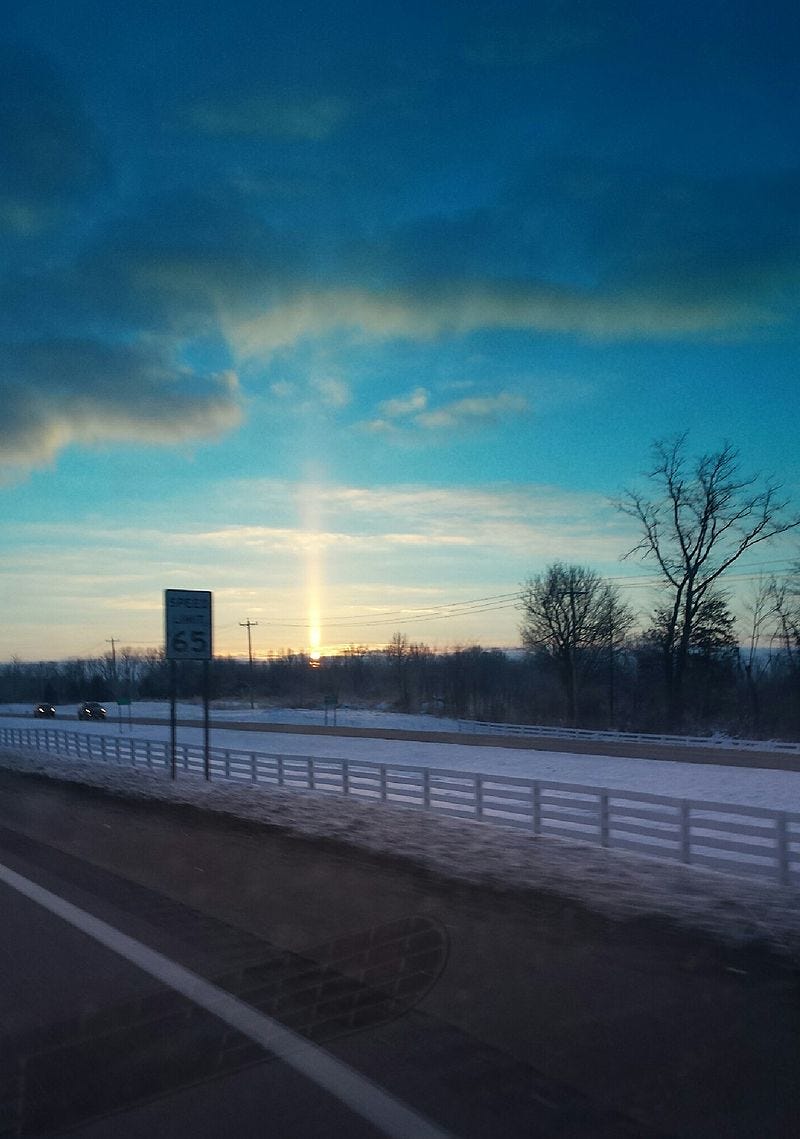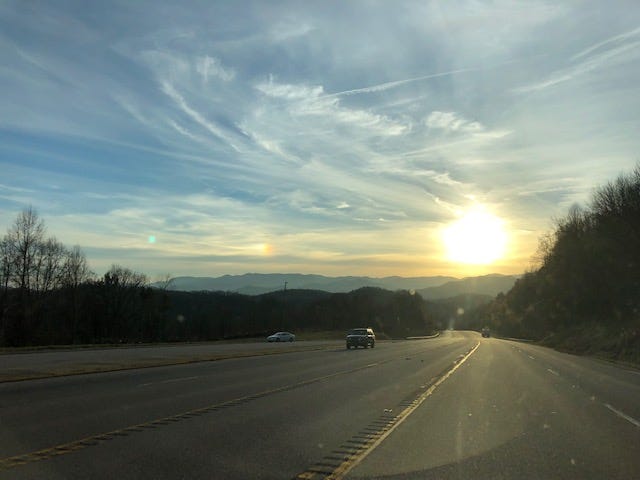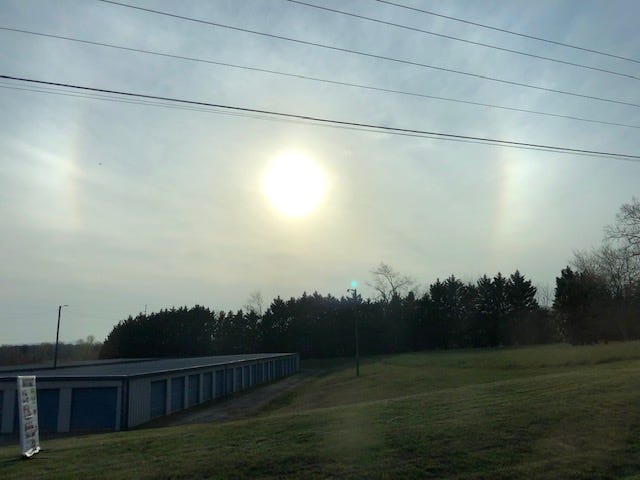What is a sundog?
Welcome to Natural Wonders, where we’re thankful for nature’s fascinating ability to adapt by growing trees on stilts and oaks built to survive hurricanes. If you were forwarded this email and want a little nature in your inbox each month, subscribe below:
Happy Thanksgiving to all of you in the United States or elsewhere who are celebrating right now! I love Thanksgiving since it is one holiday that hasn’t become over-commercialized – no gifts, nothing to buy or sell other than food, few decorations, just a chance to get together with family and friends and feel gratitude and contentment for the chance to be together.
Thank you for being on this Natural Wonders journey with me as we admire how nature works!
This week: sundogs!
I took the picture above on a trip to North Carolina not long ago. If you look closely, you can see a bright spot to the left of the sun – it almost looks like a miniature rainbow, an iridescent cloud following (or “dogging”) the sun as it’s getting ready to set.
As a child, I was told these are called Sundogs, but what are they? What causes them, and do they portend anything about the upcoming weather? Why do I sometimes see two of them, one on each side of the sun?
What are sundogs?
Digging into sundogs actually took me down an interesting rabbit hole about different types of sky-related phenomena. Sundogs aren’t the only weird cloud-related phenomena in the sky – the sun bouncing off clouds results in all sorts of fun and even spooky situations.
Sundogs
First, sundogs: I almost always see sundogs in the winter, and that’s by design – sundogs occur when thin cirrus or cirrostratus clouds of ice crystals hover in the sky while the sun is near the horizon (before doing this research, I’d never realized that I’ve only ever seen sundogs near sunset). The bright spots of the “dogs” are usually exactly 22° away from the sun and flank both sides on the same level as the sun.

The red side of a sundog is always closest to the sun, and gradually moves through the colors of the rainbow, though the darker colors are harder to see. The hexagonal ice crystals in the clouds act like prisms, refracting the sun’s light at exactly a 22° angle as they fall through the air:

These ice crystals in the thin clouds near the sun usually mean some sort of inclement weather is on the way, though it can also be caused when diamond dust is in the air – tiny ice crystals that drift downward in nearly clear skies. This short video of diamond dust in Yellowstone National Park is a beautiful example:
While they are also called “mock suns” and “parhelions,” the term “sundogs” comes from their habit of “dogging” the sun as it crosses the sky.
Sun Halos
Sundogs oftentimes occur simultaneously with sun halos. You can see a slight halo forming in this picture I took last year (somehow, I always see these while driving…)
In this case, the ice crystals in these cirrus clouds were not oriented horizontal to the ground (as in the illustration above) but are randomly scattered throughout the cloud. Sunlight didn’t get concentrated into a bright sundog, but it was still refracted into a rainbow-like reflection. Sometimes you’ll see a complete halo around the sun, and if you’re lucky you could also see a moon halo on cold, full-moon nights.
Circumzenithal arc
My bookclub friend Kathy caught a picture of a circumzenithal arc, which can occur at the same time as a sundog, but is situated overhead and so is oftentimes overlooked:
These arcs are one of the brightest and most colorful types of halos. They always occur above the sun (not to the side, like sundogs) and are found pretty far away – the sun has to be lower than 32° but the arc is usually almost overhead. They’re sometimes called upside down rainbows. Notice the thin clouds in the picture above -- circumzenithal arcs are caused by the same ice crystal clouds as halos and sundogs.
Glories
Here’s where things start getting weirder. Sometimes, if you’re high above the clouds in a tall building, airplane, or mountain above the clouds, the sun behind you will cause a rainbow-colored halo called a glory to form around your reflection. In the image below, you can tell the passenger taking this photo was seated in front of the wings because the halo is always centered around the photographer.

Glories are reflected on clouds of water droplets (not ice) below the observer.
Brocken’s Spectre
One particular type of glory is called Brocken’s Spectre, which is when your reflection is projected on nearby clouds or mist. It can be particularly spooky because it’s often larger than life and will sometimes appear to move on its own as the clouds shift. This would definitely creep me out:

Sometimes these spectres have a rainbow-colored glory around them, but other times they don’t. I’m wondering how many Bigfoot sightings could possibly be traced back to Brocken’s Spectres? Scroll through the comments on the video above to see some other great examples.
Light Pillars
Finally, take a look at this beautiful scene:

You’re looking at light pillars, created when light from artificial lights in Canada shone upward through diamond dust hovering in the air. I’ve never seen this, but I expect it would be awe-inspiring. Occasionally, a light pillar will form above the sun, or even the moon, when ice crystals are in the air:

Mike Sowden wrote a great issue about this phenomenon in his fantastic newsletter Everything Is Amazing:


Mike argues they don’t really exist – in the same way that rainbows don’t really exist, but are an illusion created by sunlight and water vapor. The same can be said about light pillars, sundogs, Brocken’s Spectres, etc.
What do you think? Do sundogs, glories, and Brocken’s Spectres really exist?
If you liked this issue, please click the “like” button below - it makes me happy and also raises the profile of this newsletter!






Wow, I don't know if I've ever seen these, but they are fascinating. They are reported from New Zealand but I wonder if they are rarer as it never gets so cold.
A balm for my eyes, this whole edition. (And thank you for the mention of my Twitter thread!)
I also love how we're all transfixed by that same Brocken Spectre video on Twitter - I was planning to share it sometime soon (if Twitter doesn't explode, obvs), and then I got Freya Rohn's latest newsletter and it was there too (https://ariadnearchive.substack.com/p/commonplacing-269/comments) and now yours as well! I kinda love that. Some chap out for a walk sees a weird thing, and it ripples out into the world first on Twitter and then in dozens of newsletters. This is the way wonder should work.
At the same time - I've never seen a Brocken Spectre or a light pillar. I've written about them but the reality of them haunts me from a distance. Ditto the Northern Lights - I keep getting pinged by my AuroraWatch app and leap out into the night to find the skies are cloud-locked tighter than Fort Knox. I'm hoping for some incredibly clear but terminally cold geomagnetically active night soon, so I can wander out onto the beach and see the Lights, just before I freeze solid while stood upright, and someone walking their dog in the morning finds me stood there with an expression of pure delight on my face. That would be a good way to go...
Or I could just get a fleece balaclava?
Tell you what, I'll get a fleece balaclava. And a thermos flask.
Yeah, okay. I like that plan better.